Case Analysis Of Patient Post Bowel Respection Surgery
VerifiedAdded on 2022/07/28
|9
|2296
|40
AI Summary
Must use RLT model and levett-jones clinical reasoning cycle in reference. Minimum 5 references.
Contribute Materials
Your contribution can guide someone’s learning journey. Share your
documents today.
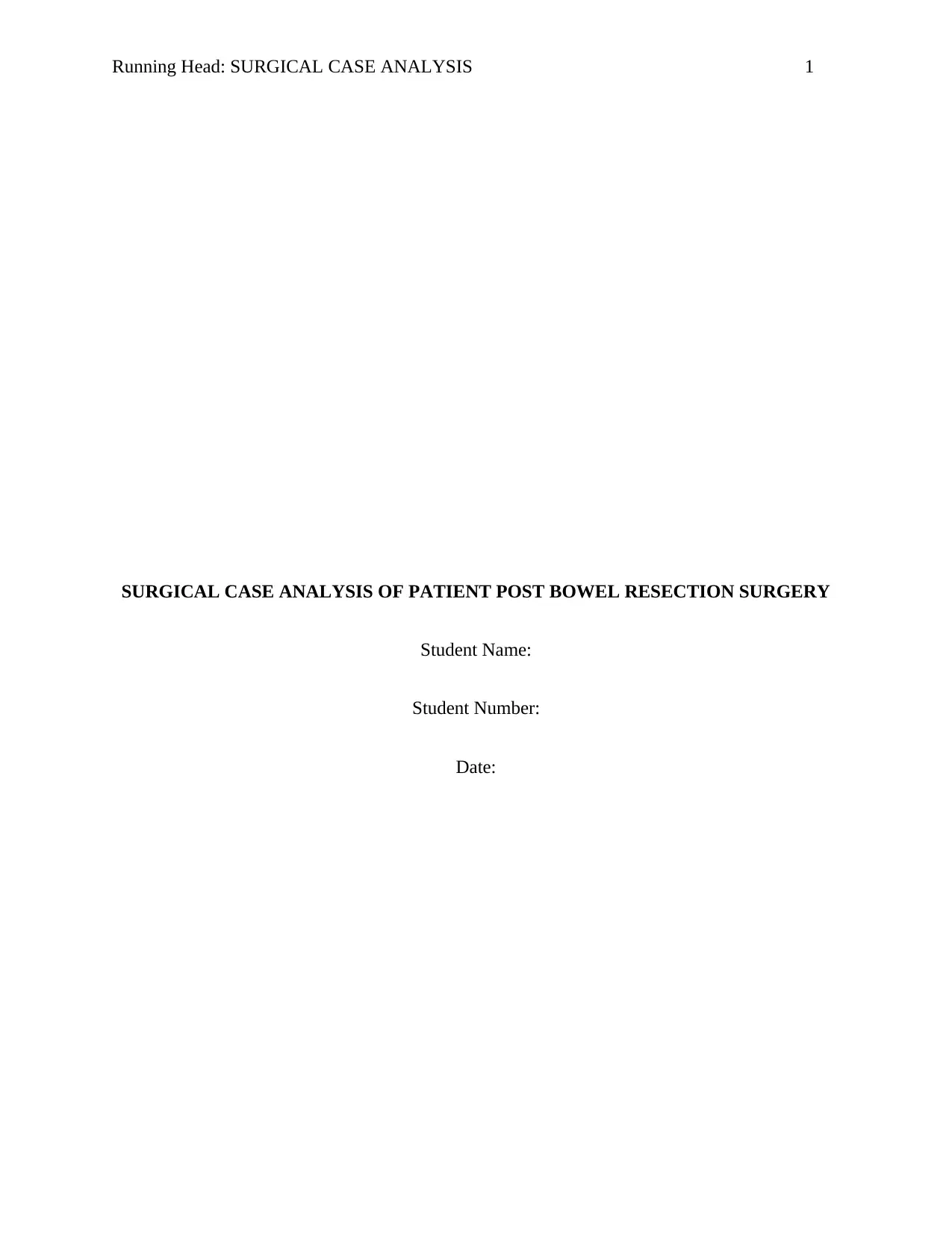
Running Head: SURGICAL CASE ANALYSIS 1
SURGICAL CASE ANALYSIS OF PATIENT POST BOWEL RESECTION SURGERY
Student Name:
Student Number:
Date:
SURGICAL CASE ANALYSIS OF PATIENT POST BOWEL RESECTION SURGERY
Student Name:
Student Number:
Date:
Secure Best Marks with AI Grader
Need help grading? Try our AI Grader for instant feedback on your assignments.
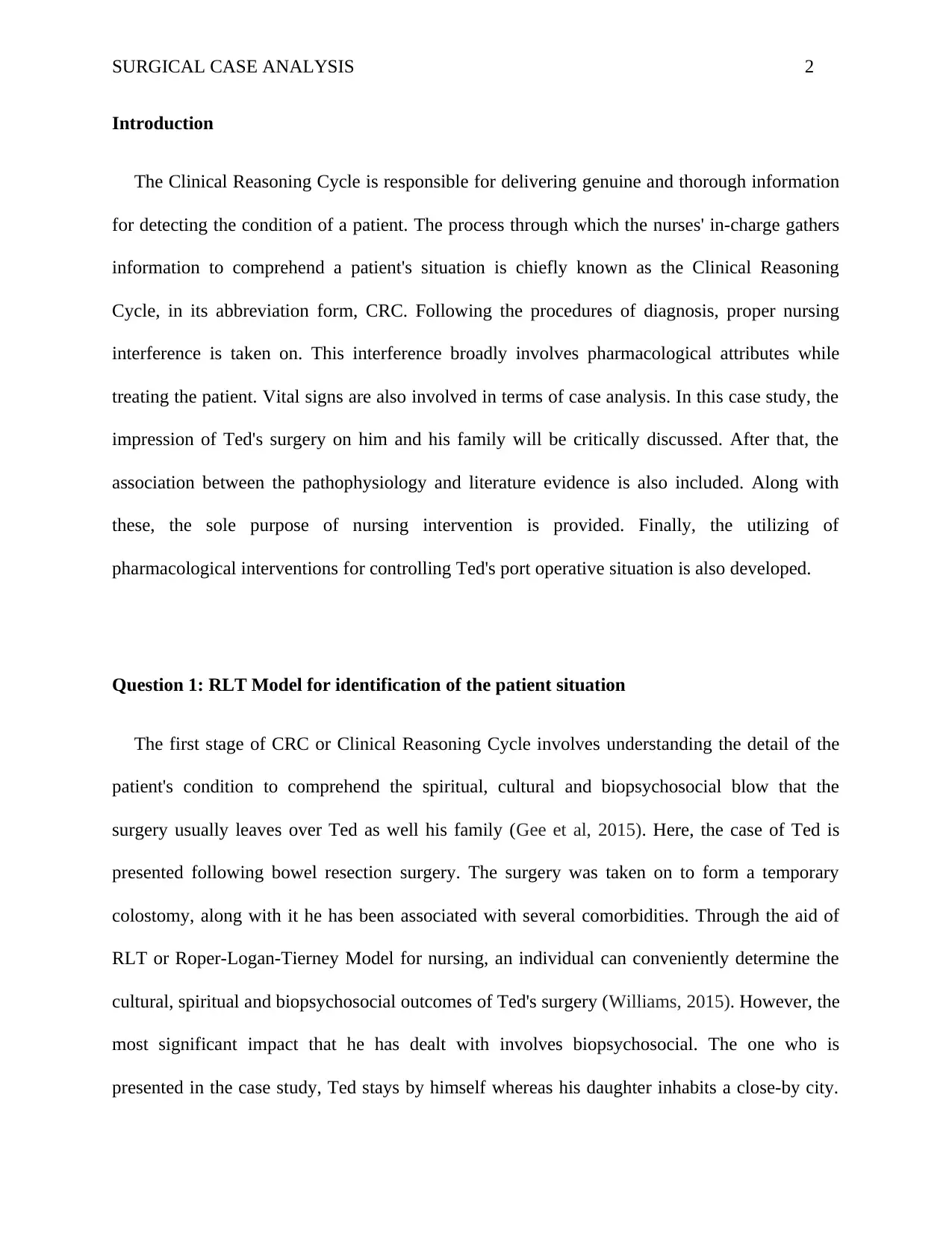
SURGICAL CASE ANALYSIS 2
Introduction
The Clinical Reasoning Cycle is responsible for delivering genuine and thorough information
for detecting the condition of a patient. The process through which the nurses' in-charge gathers
information to comprehend a patient's situation is chiefly known as the Clinical Reasoning
Cycle, in its abbreviation form, CRC. Following the procedures of diagnosis, proper nursing
interference is taken on. This interference broadly involves pharmacological attributes while
treating the patient. Vital signs are also involved in terms of case analysis. In this case study, the
impression of Ted's surgery on him and his family will be critically discussed. After that, the
association between the pathophysiology and literature evidence is also included. Along with
these, the sole purpose of nursing intervention is provided. Finally, the utilizing of
pharmacological interventions for controlling Ted's port operative situation is also developed.
Question 1: RLT Model for identification of the patient situation
The first stage of CRC or Clinical Reasoning Cycle involves understanding the detail of the
patient's condition to comprehend the spiritual, cultural and biopsychosocial blow that the
surgery usually leaves over Ted as well his family (Gee et al, 2015). Here, the case of Ted is
presented following bowel resection surgery. The surgery was taken on to form a temporary
colostomy, along with it he has been associated with several comorbidities. Through the aid of
RLT or Roper-Logan-Tierney Model for nursing, an individual can conveniently determine the
cultural, spiritual and biopsychosocial outcomes of Ted's surgery (Williams, 2015). However, the
most significant impact that he has dealt with involves biopsychosocial. The one who is
presented in the case study, Ted stays by himself whereas his daughter inhabits a close-by city.
Introduction
The Clinical Reasoning Cycle is responsible for delivering genuine and thorough information
for detecting the condition of a patient. The process through which the nurses' in-charge gathers
information to comprehend a patient's situation is chiefly known as the Clinical Reasoning
Cycle, in its abbreviation form, CRC. Following the procedures of diagnosis, proper nursing
interference is taken on. This interference broadly involves pharmacological attributes while
treating the patient. Vital signs are also involved in terms of case analysis. In this case study, the
impression of Ted's surgery on him and his family will be critically discussed. After that, the
association between the pathophysiology and literature evidence is also included. Along with
these, the sole purpose of nursing intervention is provided. Finally, the utilizing of
pharmacological interventions for controlling Ted's port operative situation is also developed.
Question 1: RLT Model for identification of the patient situation
The first stage of CRC or Clinical Reasoning Cycle involves understanding the detail of the
patient's condition to comprehend the spiritual, cultural and biopsychosocial blow that the
surgery usually leaves over Ted as well his family (Gee et al, 2015). Here, the case of Ted is
presented following bowel resection surgery. The surgery was taken on to form a temporary
colostomy, along with it he has been associated with several comorbidities. Through the aid of
RLT or Roper-Logan-Tierney Model for nursing, an individual can conveniently determine the
cultural, spiritual and biopsychosocial outcomes of Ted's surgery (Williams, 2015). However, the
most significant impact that he has dealt with involves biopsychosocial. The one who is
presented in the case study, Ted stays by himself whereas his daughter inhabits a close-by city.
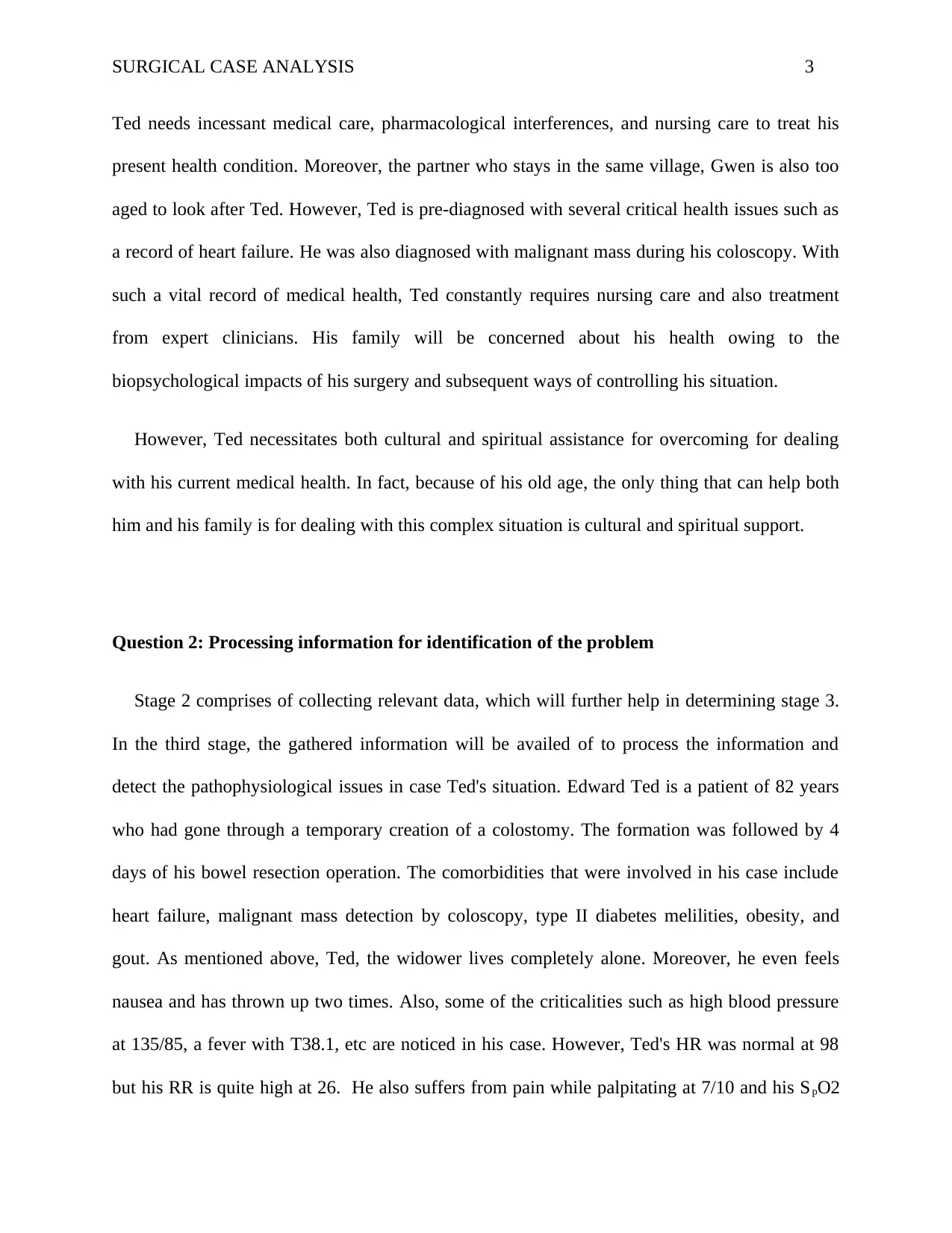
SURGICAL CASE ANALYSIS 3
Ted needs incessant medical care, pharmacological interferences, and nursing care to treat his
present health condition. Moreover, the partner who stays in the same village, Gwen is also too
aged to look after Ted. However, Ted is pre-diagnosed with several critical health issues such as
a record of heart failure. He was also diagnosed with malignant mass during his coloscopy. With
such a vital record of medical health, Ted constantly requires nursing care and also treatment
from expert clinicians. His family will be concerned about his health owing to the
biopsychological impacts of his surgery and subsequent ways of controlling his situation.
However, Ted necessitates both cultural and spiritual assistance for overcoming for dealing
with his current medical health. In fact, because of his old age, the only thing that can help both
him and his family is for dealing with this complex situation is cultural and spiritual support.
Question 2: Processing information for identification of the problem
Stage 2 comprises of collecting relevant data, which will further help in determining stage 3.
In the third stage, the gathered information will be availed of to process the information and
detect the pathophysiological issues in case Ted's situation. Edward Ted is a patient of 82 years
who had gone through a temporary creation of a colostomy. The formation was followed by 4
days of his bowel resection operation. The comorbidities that were involved in his case include
heart failure, malignant mass detection by coloscopy, type II diabetes melilities, obesity, and
gout. As mentioned above, Ted, the widower lives completely alone. Moreover, he even feels
nausea and has thrown up two times. Also, some of the criticalities such as high blood pressure
at 135/85, a fever with T38.1, etc are noticed in his case. However, Ted's HR was normal at 98
but his RR is quite high at 26. He also suffers from pain while palpitating at 7/10 and his SpO2
Ted needs incessant medical care, pharmacological interferences, and nursing care to treat his
present health condition. Moreover, the partner who stays in the same village, Gwen is also too
aged to look after Ted. However, Ted is pre-diagnosed with several critical health issues such as
a record of heart failure. He was also diagnosed with malignant mass during his coloscopy. With
such a vital record of medical health, Ted constantly requires nursing care and also treatment
from expert clinicians. His family will be concerned about his health owing to the
biopsychological impacts of his surgery and subsequent ways of controlling his situation.
However, Ted necessitates both cultural and spiritual assistance for overcoming for dealing
with his current medical health. In fact, because of his old age, the only thing that can help both
him and his family is for dealing with this complex situation is cultural and spiritual support.
Question 2: Processing information for identification of the problem
Stage 2 comprises of collecting relevant data, which will further help in determining stage 3.
In the third stage, the gathered information will be availed of to process the information and
detect the pathophysiological issues in case Ted's situation. Edward Ted is a patient of 82 years
who had gone through a temporary creation of a colostomy. The formation was followed by 4
days of his bowel resection operation. The comorbidities that were involved in his case include
heart failure, malignant mass detection by coloscopy, type II diabetes melilities, obesity, and
gout. As mentioned above, Ted, the widower lives completely alone. Moreover, he even feels
nausea and has thrown up two times. Also, some of the criticalities such as high blood pressure
at 135/85, a fever with T38.1, etc are noticed in his case. However, Ted's HR was normal at 98
but his RR is quite high at 26. He also suffers from pain while palpitating at 7/10 and his SpO2
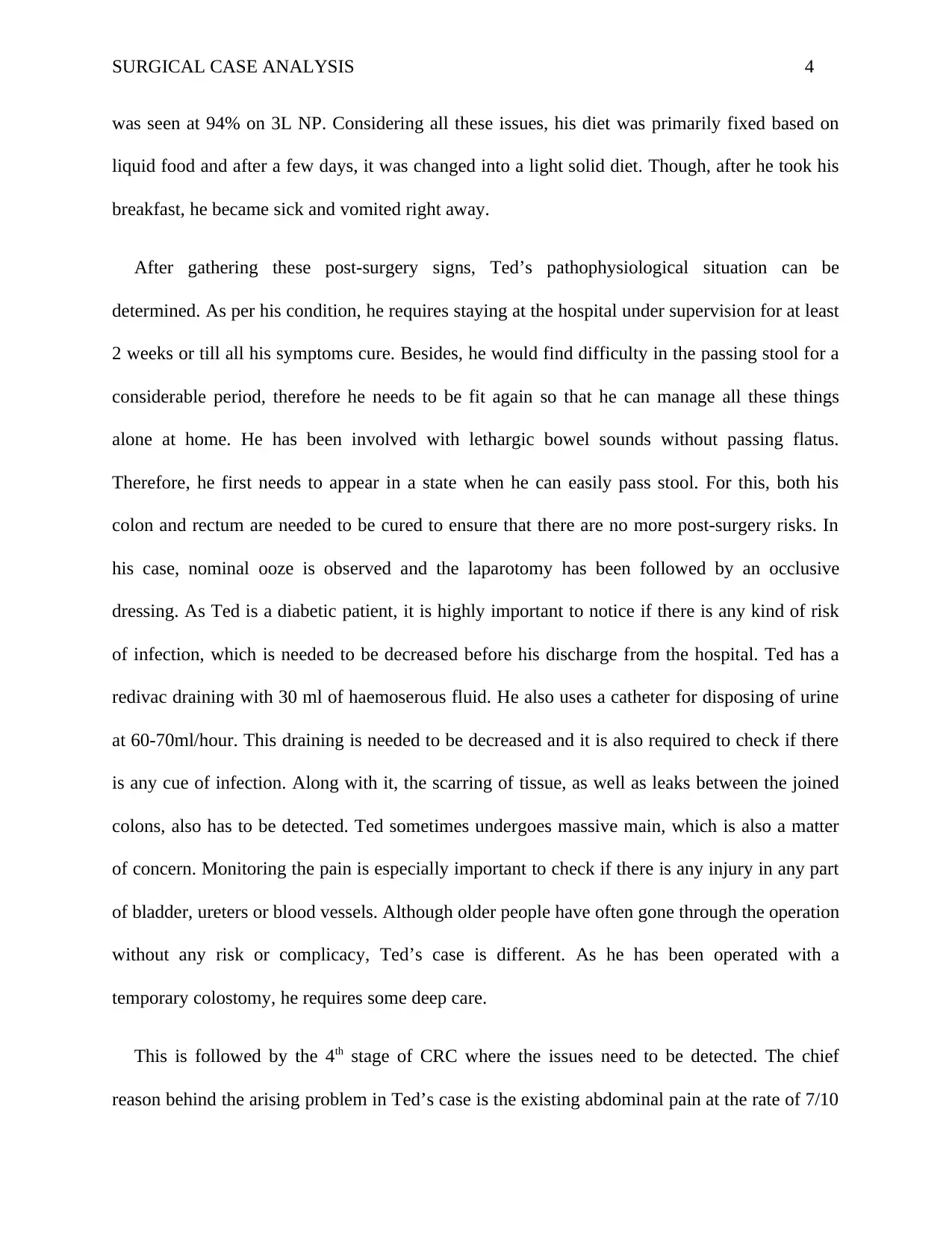
SURGICAL CASE ANALYSIS 4
was seen at 94% on 3L NP. Considering all these issues, his diet was primarily fixed based on
liquid food and after a few days, it was changed into a light solid diet. Though, after he took his
breakfast, he became sick and vomited right away.
After gathering these post-surgery signs, Ted’s pathophysiological situation can be
determined. As per his condition, he requires staying at the hospital under supervision for at least
2 weeks or till all his symptoms cure. Besides, he would find difficulty in the passing stool for a
considerable period, therefore he needs to be fit again so that he can manage all these things
alone at home. He has been involved with lethargic bowel sounds without passing flatus.
Therefore, he first needs to appear in a state when he can easily pass stool. For this, both his
colon and rectum are needed to be cured to ensure that there are no more post-surgery risks. In
his case, nominal ooze is observed and the laparotomy has been followed by an occlusive
dressing. As Ted is a diabetic patient, it is highly important to notice if there is any kind of risk
of infection, which is needed to be decreased before his discharge from the hospital. Ted has a
redivac draining with 30 ml of haemoserous fluid. He also uses a catheter for disposing of urine
at 60-70ml/hour. This draining is needed to be decreased and it is also required to check if there
is any cue of infection. Along with it, the scarring of tissue, as well as leaks between the joined
colons, also has to be detected. Ted sometimes undergoes massive main, which is also a matter
of concern. Monitoring the pain is especially important to check if there is any injury in any part
of bladder, ureters or blood vessels. Although older people have often gone through the operation
without any risk or complicacy, Ted’s case is different. As he has been operated with a
temporary colostomy, he requires some deep care.
This is followed by the 4th stage of CRC where the issues need to be detected. The chief
reason behind the arising problem in Ted’s case is the existing abdominal pain at the rate of 7/10
was seen at 94% on 3L NP. Considering all these issues, his diet was primarily fixed based on
liquid food and after a few days, it was changed into a light solid diet. Though, after he took his
breakfast, he became sick and vomited right away.
After gathering these post-surgery signs, Ted’s pathophysiological situation can be
determined. As per his condition, he requires staying at the hospital under supervision for at least
2 weeks or till all his symptoms cure. Besides, he would find difficulty in the passing stool for a
considerable period, therefore he needs to be fit again so that he can manage all these things
alone at home. He has been involved with lethargic bowel sounds without passing flatus.
Therefore, he first needs to appear in a state when he can easily pass stool. For this, both his
colon and rectum are needed to be cured to ensure that there are no more post-surgery risks. In
his case, nominal ooze is observed and the laparotomy has been followed by an occlusive
dressing. As Ted is a diabetic patient, it is highly important to notice if there is any kind of risk
of infection, which is needed to be decreased before his discharge from the hospital. Ted has a
redivac draining with 30 ml of haemoserous fluid. He also uses a catheter for disposing of urine
at 60-70ml/hour. This draining is needed to be decreased and it is also required to check if there
is any cue of infection. Along with it, the scarring of tissue, as well as leaks between the joined
colons, also has to be detected. Ted sometimes undergoes massive main, which is also a matter
of concern. Monitoring the pain is especially important to check if there is any injury in any part
of bladder, ureters or blood vessels. Although older people have often gone through the operation
without any risk or complicacy, Ted’s case is different. As he has been operated with a
temporary colostomy, he requires some deep care.
This is followed by the 4th stage of CRC where the issues need to be detected. The chief
reason behind the arising problem in Ted’s case is the existing abdominal pain at the rate of 7/10
Secure Best Marks with AI Grader
Need help grading? Try our AI Grader for instant feedback on your assignments.
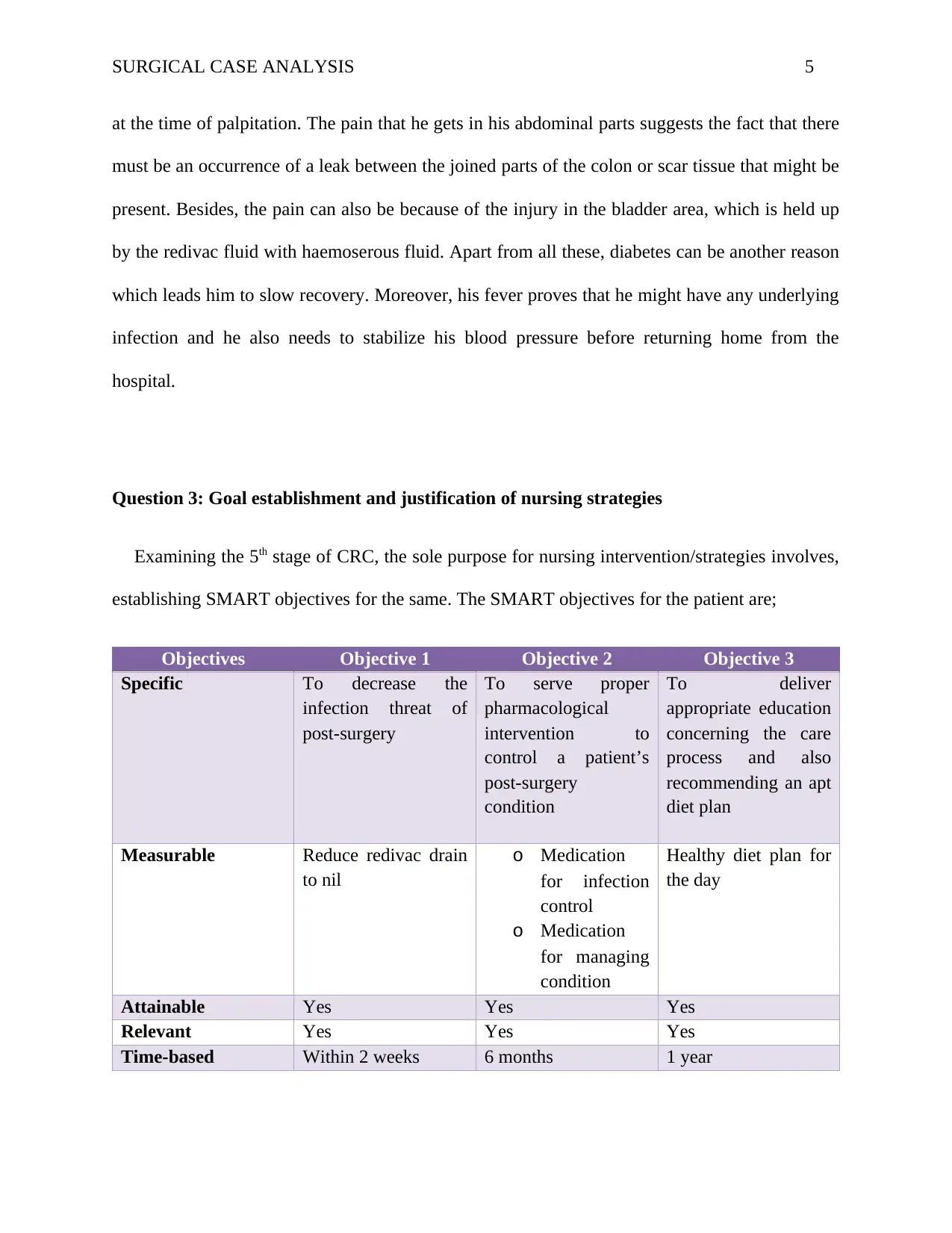
SURGICAL CASE ANALYSIS 5
at the time of palpitation. The pain that he gets in his abdominal parts suggests the fact that there
must be an occurrence of a leak between the joined parts of the colon or scar tissue that might be
present. Besides, the pain can also be because of the injury in the bladder area, which is held up
by the redivac fluid with haemoserous fluid. Apart from all these, diabetes can be another reason
which leads him to slow recovery. Moreover, his fever proves that he might have any underlying
infection and he also needs to stabilize his blood pressure before returning home from the
hospital.
Question 3: Goal establishment and justification of nursing strategies
Examining the 5th stage of CRC, the sole purpose for nursing intervention/strategies involves,
establishing SMART objectives for the same. The SMART objectives for the patient are;
Objectives Objective 1 Objective 2 Objective 3
Specific To decrease the
infection threat of
post-surgery
To serve proper
pharmacological
intervention to
control a patient’s
post-surgery
condition
To deliver
appropriate education
concerning the care
process and also
recommending an apt
diet plan
Measurable Reduce redivac drain
to nil
o Medication
for infection
control
o Medication
for managing
condition
Healthy diet plan for
the day
Attainable Yes Yes Yes
Relevant Yes Yes Yes
Time-based Within 2 weeks 6 months 1 year
at the time of palpitation. The pain that he gets in his abdominal parts suggests the fact that there
must be an occurrence of a leak between the joined parts of the colon or scar tissue that might be
present. Besides, the pain can also be because of the injury in the bladder area, which is held up
by the redivac fluid with haemoserous fluid. Apart from all these, diabetes can be another reason
which leads him to slow recovery. Moreover, his fever proves that he might have any underlying
infection and he also needs to stabilize his blood pressure before returning home from the
hospital.
Question 3: Goal establishment and justification of nursing strategies
Examining the 5th stage of CRC, the sole purpose for nursing intervention/strategies involves,
establishing SMART objectives for the same. The SMART objectives for the patient are;
Objectives Objective 1 Objective 2 Objective 3
Specific To decrease the
infection threat of
post-surgery
To serve proper
pharmacological
intervention to
control a patient’s
post-surgery
condition
To deliver
appropriate education
concerning the care
process and also
recommending an apt
diet plan
Measurable Reduce redivac drain
to nil
o Medication
for infection
control
o Medication
for managing
condition
Healthy diet plan for
the day
Attainable Yes Yes Yes
Relevant Yes Yes Yes
Time-based Within 2 weeks 6 months 1 year
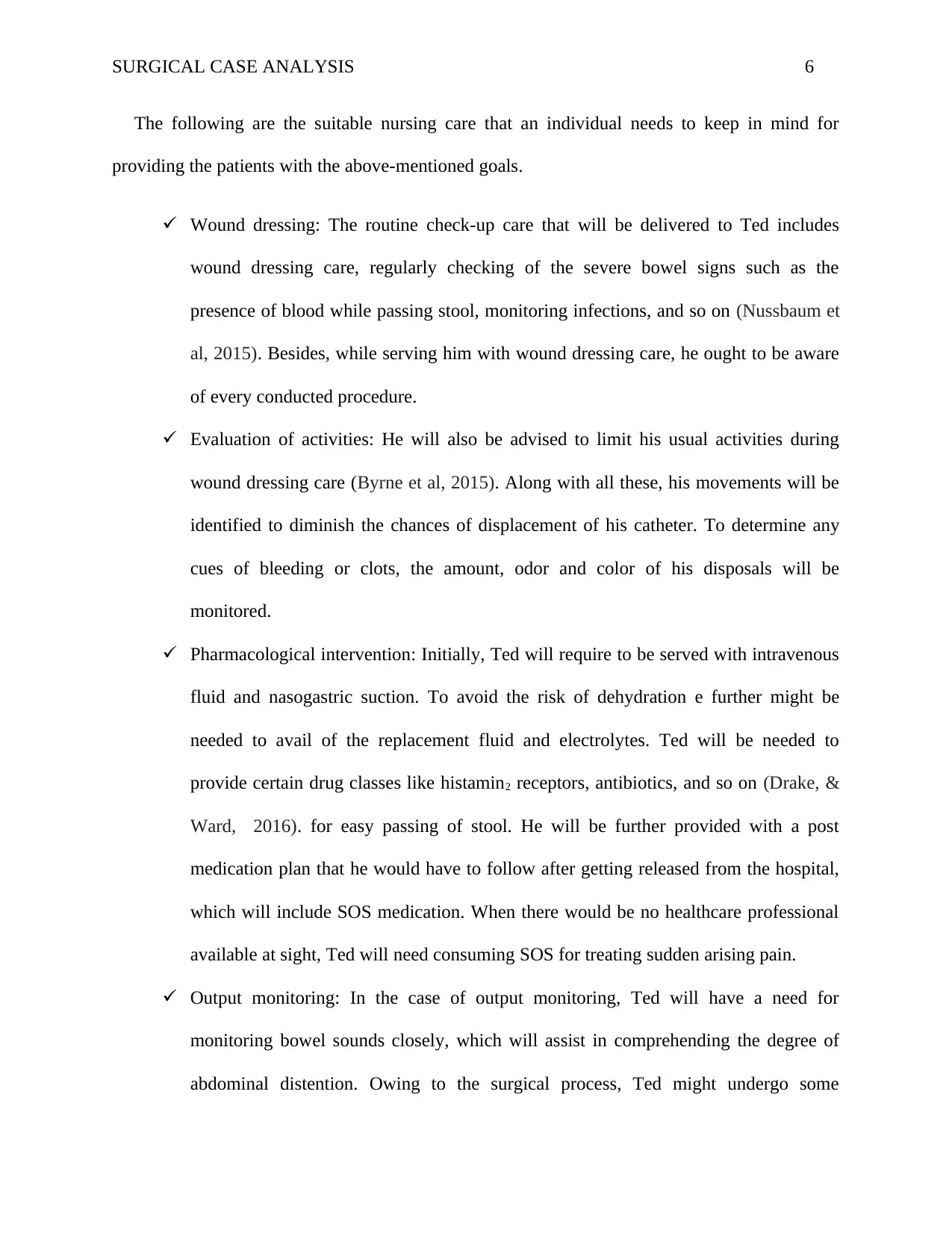
SURGICAL CASE ANALYSIS 6
The following are the suitable nursing care that an individual needs to keep in mind for
providing the patients with the above-mentioned goals.
Wound dressing: The routine check-up care that will be delivered to Ted includes
wound dressing care, regularly checking of the severe bowel signs such as the
presence of blood while passing stool, monitoring infections, and so on (Nussbaum et
al, 2015). Besides, while serving him with wound dressing care, he ought to be aware
of every conducted procedure.
Evaluation of activities: He will also be advised to limit his usual activities during
wound dressing care (Byrne et al, 2015). Along with all these, his movements will be
identified to diminish the chances of displacement of his catheter. To determine any
cues of bleeding or clots, the amount, odor and color of his disposals will be
monitored.
Pharmacological intervention: Initially, Ted will require to be served with intravenous
fluid and nasogastric suction. To avoid the risk of dehydration e further might be
needed to avail of the replacement fluid and electrolytes. Ted will be needed to
provide certain drug classes like histamin2 receptors, antibiotics, and so on (Drake, &
Ward, 2016). for easy passing of stool. He will be further provided with a post
medication plan that he would have to follow after getting released from the hospital,
which will include SOS medication. When there would be no healthcare professional
available at sight, Ted will need consuming SOS for treating sudden arising pain.
Output monitoring: In the case of output monitoring, Ted will have a need for
monitoring bowel sounds closely, which will assist in comprehending the degree of
abdominal distention. Owing to the surgical process, Ted might undergo some
The following are the suitable nursing care that an individual needs to keep in mind for
providing the patients with the above-mentioned goals.
Wound dressing: The routine check-up care that will be delivered to Ted includes
wound dressing care, regularly checking of the severe bowel signs such as the
presence of blood while passing stool, monitoring infections, and so on (Nussbaum et
al, 2015). Besides, while serving him with wound dressing care, he ought to be aware
of every conducted procedure.
Evaluation of activities: He will also be advised to limit his usual activities during
wound dressing care (Byrne et al, 2015). Along with all these, his movements will be
identified to diminish the chances of displacement of his catheter. To determine any
cues of bleeding or clots, the amount, odor and color of his disposals will be
monitored.
Pharmacological intervention: Initially, Ted will require to be served with intravenous
fluid and nasogastric suction. To avoid the risk of dehydration e further might be
needed to avail of the replacement fluid and electrolytes. Ted will be needed to
provide certain drug classes like histamin2 receptors, antibiotics, and so on (Drake, &
Ward, 2016). for easy passing of stool. He will be further provided with a post
medication plan that he would have to follow after getting released from the hospital,
which will include SOS medication. When there would be no healthcare professional
available at sight, Ted will need consuming SOS for treating sudden arising pain.
Output monitoring: In the case of output monitoring, Ted will have a need for
monitoring bowel sounds closely, which will assist in comprehending the degree of
abdominal distention. Owing to the surgical process, Ted might undergo some
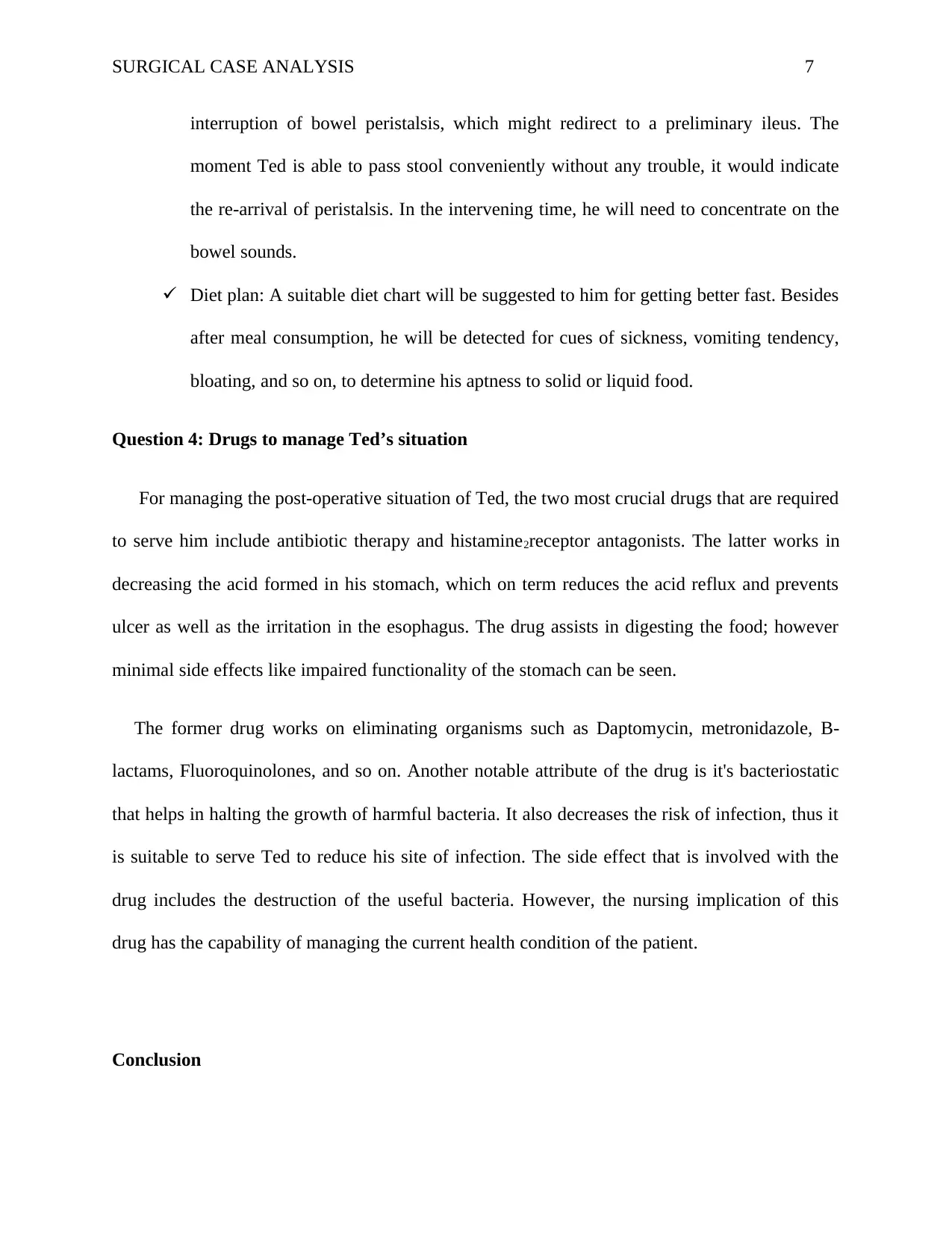
SURGICAL CASE ANALYSIS 7
interruption of bowel peristalsis, which might redirect to a preliminary ileus. The
moment Ted is able to pass stool conveniently without any trouble, it would indicate
the re-arrival of peristalsis. In the intervening time, he will need to concentrate on the
bowel sounds.
Diet plan: A suitable diet chart will be suggested to him for getting better fast. Besides
after meal consumption, he will be detected for cues of sickness, vomiting tendency,
bloating, and so on, to determine his aptness to solid or liquid food.
Question 4: Drugs to manage Ted’s situation
For managing the post-operative situation of Ted, the two most crucial drugs that are required
to serve him include antibiotic therapy and histamine2receptor antagonists. The latter works in
decreasing the acid formed in his stomach, which on term reduces the acid reflux and prevents
ulcer as well as the irritation in the esophagus. The drug assists in digesting the food; however
minimal side effects like impaired functionality of the stomach can be seen.
The former drug works on eliminating organisms such as Daptomycin, metronidazole, B-
lactams, Fluoroquinolones, and so on. Another notable attribute of the drug is it's bacteriostatic
that helps in halting the growth of harmful bacteria. It also decreases the risk of infection, thus it
is suitable to serve Ted to reduce his site of infection. The side effect that is involved with the
drug includes the destruction of the useful bacteria. However, the nursing implication of this
drug has the capability of managing the current health condition of the patient.
Conclusion
interruption of bowel peristalsis, which might redirect to a preliminary ileus. The
moment Ted is able to pass stool conveniently without any trouble, it would indicate
the re-arrival of peristalsis. In the intervening time, he will need to concentrate on the
bowel sounds.
Diet plan: A suitable diet chart will be suggested to him for getting better fast. Besides
after meal consumption, he will be detected for cues of sickness, vomiting tendency,
bloating, and so on, to determine his aptness to solid or liquid food.
Question 4: Drugs to manage Ted’s situation
For managing the post-operative situation of Ted, the two most crucial drugs that are required
to serve him include antibiotic therapy and histamine2receptor antagonists. The latter works in
decreasing the acid formed in his stomach, which on term reduces the acid reflux and prevents
ulcer as well as the irritation in the esophagus. The drug assists in digesting the food; however
minimal side effects like impaired functionality of the stomach can be seen.
The former drug works on eliminating organisms such as Daptomycin, metronidazole, B-
lactams, Fluoroquinolones, and so on. Another notable attribute of the drug is it's bacteriostatic
that helps in halting the growth of harmful bacteria. It also decreases the risk of infection, thus it
is suitable to serve Ted to reduce his site of infection. The side effect that is involved with the
drug includes the destruction of the useful bacteria. However, the nursing implication of this
drug has the capability of managing the current health condition of the patient.
Conclusion
Paraphrase This Document
Need a fresh take? Get an instant paraphrase of this document with our AI Paraphraser
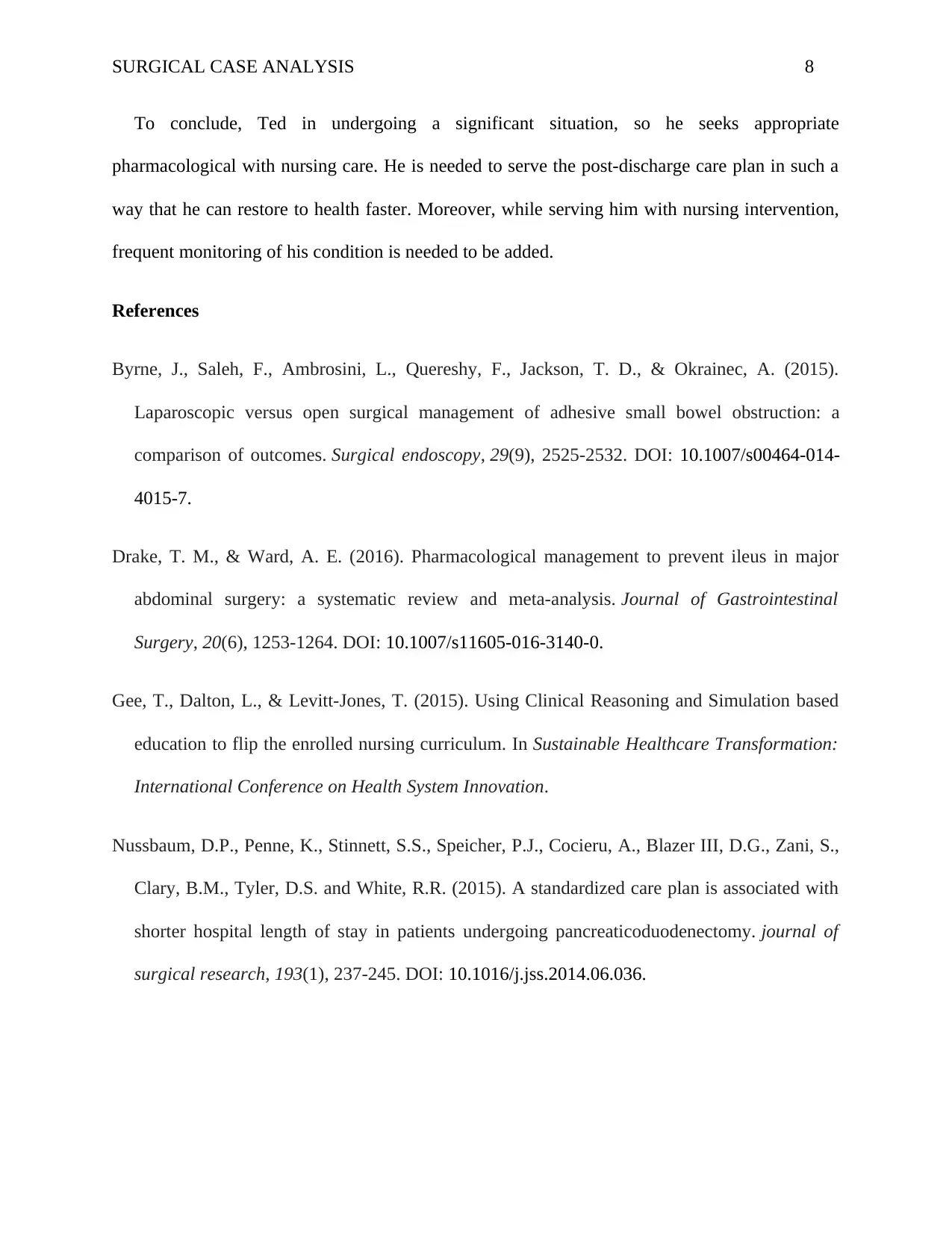
SURGICAL CASE ANALYSIS 8
To conclude, Ted in undergoing a significant situation, so he seeks appropriate
pharmacological with nursing care. He is needed to serve the post-discharge care plan in such a
way that he can restore to health faster. Moreover, while serving him with nursing intervention,
frequent monitoring of his condition is needed to be added.
References
Byrne, J., Saleh, F., Ambrosini, L., Quereshy, F., Jackson, T. D., & Okrainec, A. (2015).
Laparoscopic versus open surgical management of adhesive small bowel obstruction: a
comparison of outcomes. Surgical endoscopy, 29(9), 2525-2532. DOI: 10.1007/s00464-014-
4015-7.
Drake, T. M., & Ward, A. E. (2016). Pharmacological management to prevent ileus in major
abdominal surgery: a systematic review and meta-analysis. Journal of Gastrointestinal
Surgery, 20(6), 1253-1264. DOI: 10.1007/s11605-016-3140-0.
Gee, T., Dalton, L., & Levitt-Jones, T. (2015). Using Clinical Reasoning and Simulation based
education to flip the enrolled nursing curriculum. In Sustainable Healthcare Transformation:
International Conference on Health System Innovation.
Nussbaum, D.P., Penne, K., Stinnett, S.S., Speicher, P.J., Cocieru, A., Blazer III, D.G., Zani, S.,
Clary, B.M., Tyler, D.S. and White, R.R. (2015). A standardized care plan is associated with
shorter hospital length of stay in patients undergoing pancreaticoduodenectomy. journal of
surgical research, 193(1), 237-245. DOI: 10.1016/j.jss.2014.06.036.
To conclude, Ted in undergoing a significant situation, so he seeks appropriate
pharmacological with nursing care. He is needed to serve the post-discharge care plan in such a
way that he can restore to health faster. Moreover, while serving him with nursing intervention,
frequent monitoring of his condition is needed to be added.
References
Byrne, J., Saleh, F., Ambrosini, L., Quereshy, F., Jackson, T. D., & Okrainec, A. (2015).
Laparoscopic versus open surgical management of adhesive small bowel obstruction: a
comparison of outcomes. Surgical endoscopy, 29(9), 2525-2532. DOI: 10.1007/s00464-014-
4015-7.
Drake, T. M., & Ward, A. E. (2016). Pharmacological management to prevent ileus in major
abdominal surgery: a systematic review and meta-analysis. Journal of Gastrointestinal
Surgery, 20(6), 1253-1264. DOI: 10.1007/s11605-016-3140-0.
Gee, T., Dalton, L., & Levitt-Jones, T. (2015). Using Clinical Reasoning and Simulation based
education to flip the enrolled nursing curriculum. In Sustainable Healthcare Transformation:
International Conference on Health System Innovation.
Nussbaum, D.P., Penne, K., Stinnett, S.S., Speicher, P.J., Cocieru, A., Blazer III, D.G., Zani, S.,
Clary, B.M., Tyler, D.S. and White, R.R. (2015). A standardized care plan is associated with
shorter hospital length of stay in patients undergoing pancreaticoduodenectomy. journal of
surgical research, 193(1), 237-245. DOI: 10.1016/j.jss.2014.06.036.
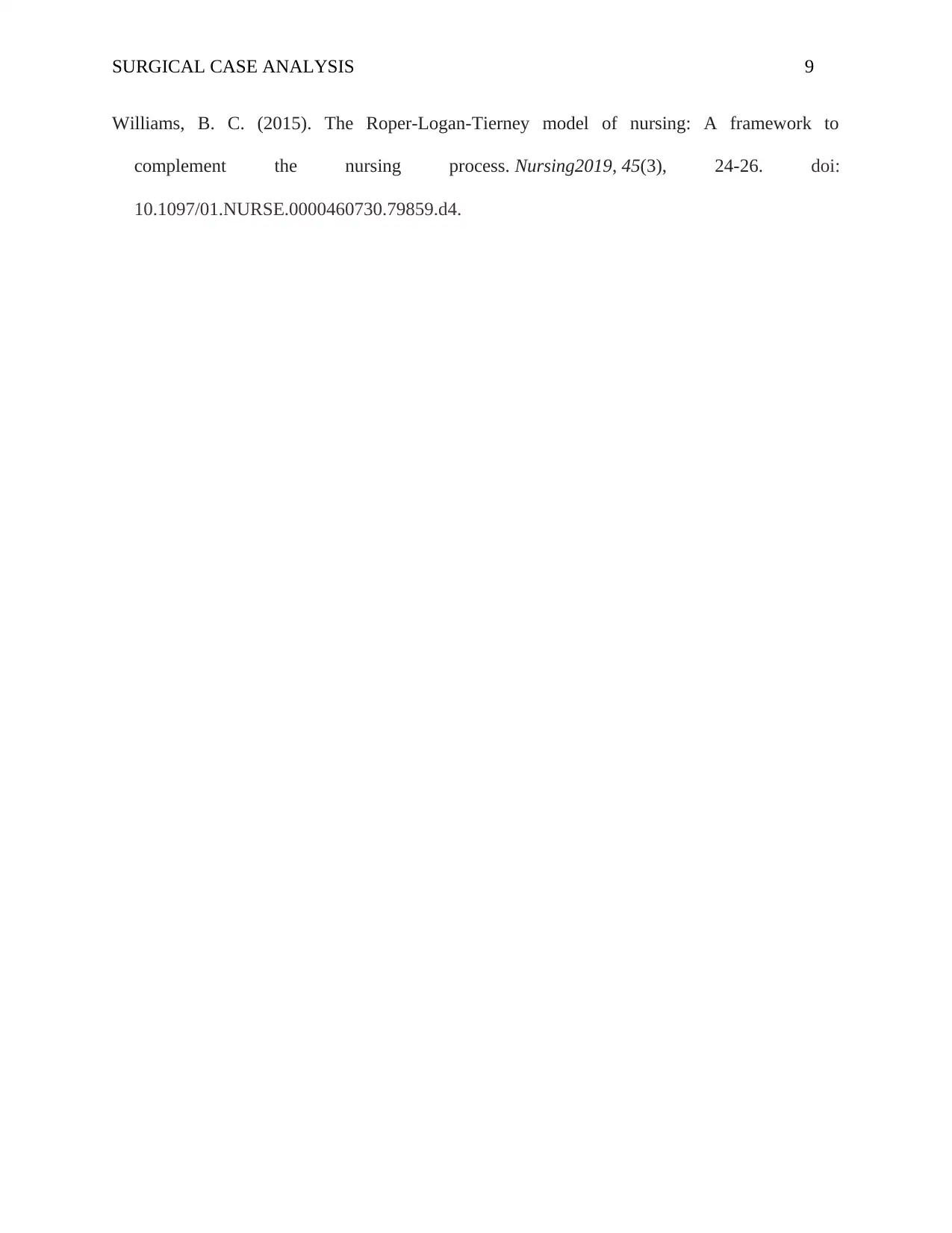
SURGICAL CASE ANALYSIS 9
Williams, B. C. (2015). The Roper-Logan-Tierney model of nursing: A framework to
complement the nursing process. Nursing2019, 45(3), 24-26. doi:
10.1097/01.NURSE.0000460730.79859.d4.
Williams, B. C. (2015). The Roper-Logan-Tierney model of nursing: A framework to
complement the nursing process. Nursing2019, 45(3), 24-26. doi:
10.1097/01.NURSE.0000460730.79859.d4.
1 out of 9
Related Documents
Your All-in-One AI-Powered Toolkit for Academic Success.
+13062052269
info@desklib.com
Available 24*7 on WhatsApp / Email
![[object Object]](/_next/static/media/star-bottom.7253800d.svg)
Unlock your academic potential
© 2024 | Zucol Services PVT LTD | All rights reserved.




